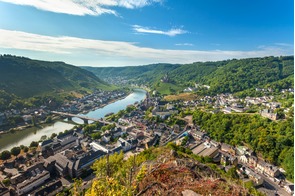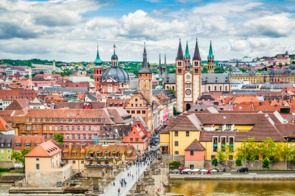
30 July
Setting sail from Luxembourg
Tiny Luxembourg's even tinier capital city enjoys a spectacular setting, perched on a dramatic bluff where the Pétrusse and Alzette rivers meet. The UNESCO-listed old town is an unexpected joy to explore, and a sizeable population of foreign workers means that the city is also a very cosmopolitan place.

31 July
Germany: Bernkastel

The pretty town of Bernkastel lies in the heart of the Moselle wine region, and is known for its excellent dry whites based on the Riesling grape. The picturesque half-timbered houses of the old town date back to the Middle Ages, and there are plenty of wine taverns where you can enjoy a glass or two.
1 August
Germany: Koblenz

Koblenz was founded by the Romans, who valued the city’s strategically important location where the Rhine and Moselle rivers meet. Rebuilt from the rubble of the Second World War, modern Koblenz has a pleasant and relaxed atmosphere, and serves as a gateway to the Romantic Rhine.
1 August
Germany: Cochem

One of the prettiest towns in the Moselle valley, Cochem is a popular stop for river cruise ships. With an old town full of half-timbered houses and a castle perched on a hill it’s a quintessentially German scene, and the riverside promenade is lovely during the sunny summer months.
2 August
Germany: Rüdesheim

The pretty little town of Rüdesheim, situated on a bend in the Rhine surrounded by vineyards, is a popular destination for travellers looking for a slice of quintessentially German village life. The Drosselgasse, a narrow cobbled lane flanked by old timber frame buildings, is particularly atmospheric.
3 August
Germany: Wertheim

The picturesque medieval town of Wertheim sits at the confluence of the Main and Tauber rivers, and is known for its castle, cobbled streets and charming half-timbered houses. The surrounding countryside is perfect for a bike ride, a gentle hike or a wine tasting tour.
4 August
Germany: Würzburg

The handsome town of Würzburg, situated on the river Main between Nuremberg and Frankfurt, was ruled for centuries by a succession of powerful prince-bishops. Although much of the city was destroyed during the Second World War, the majestic 18th century Residenz palace stands as a testament to the wealth of the bishopric.
5 August
Germany: Eltmann
6 August
Arriving in Nuremberg
Nuremberg, Bavaria's second city, first pops up in the history books in 1050 as a stronghold of the Franks, and later became the unofficial capital of the Holy Roman Empire. Nuremberg was also the centre of the German Renaissance, although in the 20th century it became associated with the Nazis; huge rallies were held here, and Nazi officials were later tried and convicted at the Nuremberg Trials. Happily Nuremberg has bounced back from those dark days, and nowadays the city is a tourist magnet thanks to the beautifully restored old town, Christmas markets and excellent beer.


Don't miss
Schwurgerichtssaal 600 (Court Room 600) of the still-working courthouse is where the Nuremberg Trials took place. It forms part of an extraordinary exhibit detailing the history of the trials.
Your home from home



What we love
These innovative ships feature a heated sun deck swimming pool with swim up bar and large 'twin balconies' in many staterooms. Enjoy the informal style during the day whilst relaxing on the Sundeck, and in the evening indulge in the gourmet cuisine in the main dining room or The Chef's Table.
| Capacity | 156 - 162 Guests |
|---|---|
| Crew | 49 European Staff |
| Style | Relaxed and informal during the day, giving way to an elegant evening atmosphere. |
| Inclusions |
|
Tailor-make your trip

Where to stay in Nuremberg
We like the Drei Raben (Three Ravens) in the rebuilt old town.

Explore Nuremberg's rich history
Nuremberg's medieval might and significance as part of the Holy Roman Empire becomes clear in a visit to the Kaiserburg.










